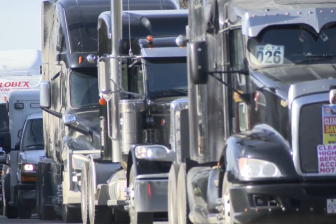Saskatoon might have reached the peak of the fifth wave of the COVID-19 pandemic.
Data released Monday indicates the virus load in the city’s wastewater decreased 39.3 per cent as of Jan. 19.
Decreases were also recorded in Prince Albert’s (58.2 per cent) and North Battleford’s (8.1 per cent) wastewater.
Read more:
Premier Moe says no new measures on the way for Saskatchewan
Omicron continues to be the main variant of concern identified in Saskatoon’s wastewater, however, it is down 49.4 per cent in the most recent analysis.
Omicron loads were also down in Prince Albert (68.2 per cent) and North Battleford (70.7 per cent).
Caution should be exercised interpreting the new wastewater numbers, said John Giesy, an ecotoxicologist at the University of Saskatchewan
He said another week is needed for a trend line to be established.
“But as of right now, unless something else changes like a new variant or new changes in regulations, it’s looking like we’re on the way down,” Giesy said.
“The bad news is, and what my colleagues at the university worry about, is the lag time for hospitalizations.”
Read more:
Trucks pass through Regina as ‘freedom convoy’ continues toward Ottawa
The Saskatchewan government reported 291 people were in hospital as of Tuesday, 33 who are in intensive care. The last time hospitalizations were this high was on Oct. 25, 2021, with 293 patients.
The province said of those in hospital, 108 – 37.3 per cent – were not fully vaccinated.
Health officials said of the 258 in-patient hospitalizations, 112 are for a COVID-19-related illness, 120 are incidental COVID-19 infections and 33 are yet to be determined.
Twenty-two people in intensive care have a COVID-19-related illness, five are incidental COVID cases and three are undetermined.
There are three children being treated in PICU / NICU for COVID-19-related illnesses.
Giesy said it typically takes a few more weeks for hospitalization numbers to trend downward, particularly if people end up in intensive care.
He believed the peak was initially reached just before students returned to school from the Christmas break.
“It went down for three days and then kids went back to school and bam, it went straight back up again. But, it turned around quickly and is headed back down, ”Giesy said.
“Our prediction is based on what we’re seeing now. There are fewer infected people shedding less virus now, and it’s trending downward. ”
View link »
© 2022 Global News, a division of Corus Entertainment Inc.
Reference-globalnews.ca


